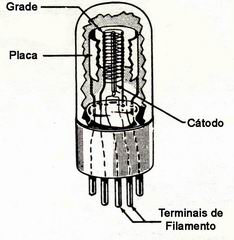The triode ages comprises the period
1913-1935, when it was introduced several innovations into the
valve manufacturing. These included high-efficiency cathodes,
suitable materials for plates and grids, new types of glass
for bulb construction, and advanced techniques in bulb evacuation.
It gave birth of the triode or a valve comprising three electrodes:
the cathode, the plate and the control grid or grid responsable
for its application properties.
When the valve is used as an amplifier, a negative dc voltage
is usually applied to the grid. Because a small voltage applied
to the grid can control a comparatively large amount of plate
current, the valve amplifies the signal.
In this phase of understanding the electrical behaviour of the
triode it gave birth of the first types of amplifying circuits,
such as the negative grid bias; also several technical concepts
including the mutual transconductance, proposed by van der Bijl,
and the graphic or curves showing the plate characteristics.
The triode was widely used in the sound reproduction system
up to mid thirties. |
 |
| The triode valve structure |
|
|
|
|
Schematical cut of a valve triode showing
its structural elements.
|
|
 |
Illustration of a plate curve in a triode
valve where:
Ia = anode current
Va = anode voltage
Vg = cathode voltage |
|
| |
 |
Some types of north-american primitive
triodes:
a)Tipo 205D manufactured by the WE in 1924
b)Tipo UV 201-A using pure tungsten filament
c)Tipo UX-201-A with filament re-covered for oxide |
|
 |
Some types of triodes of européia
origin, manufactured between 1920-1930:
a) Type E424N, used by Philips as
detector and amplifier
b) Type REN 904, similar Telefunken to type E424N
c) A131 Type, used by Philips in periods of training of
radio-frequency |
|
|
|